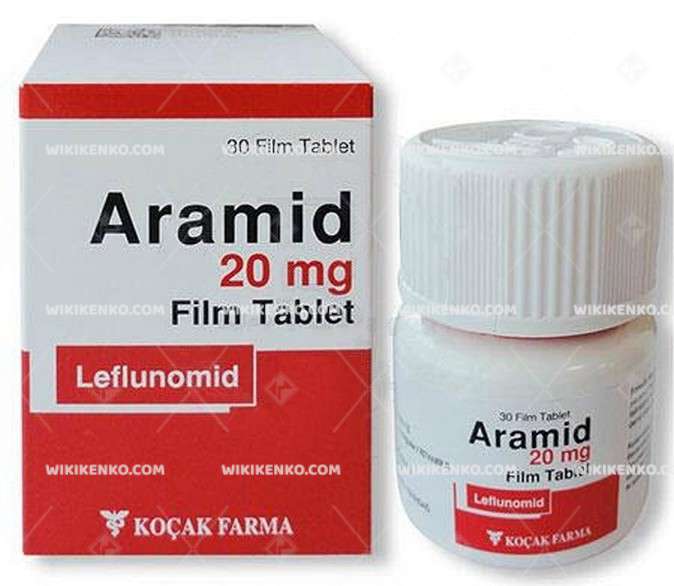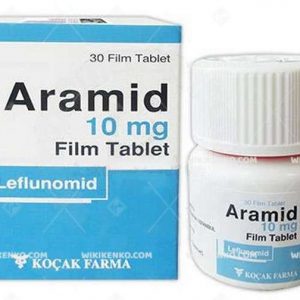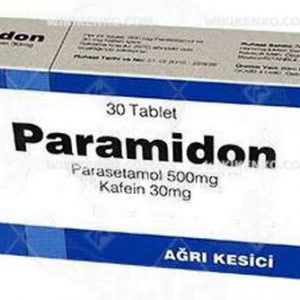Aramid Film Tablet 20 Mg
In the realm of medications for rheumatoid arthritis and psoriatic arthritis, Aramid Film Tablet 20 Mg stands as a formidable ally. This comprehensive guide provides crucial insights into this medication, encompassing its composition, physical properties, indications, contraindications, side effects, and the essential considerations for those considering its use.
| Dosage form | |
|---|---|
| Pack size | |
| Potency | 20 Mg |
| Manufacturer | |
| Origin | |
| Generic Name (Ingredient) | Combined |
Assuming your emergency circumstances for this product, visit Urgent Quotation page. Besides, for any pharmaceutical questions, please ask us in the comments section.
Description
Composition
Leflunomide – The Active Ingredient
At the core of Aramid Film Tablet 20 Mg lies leflunomide, a potent active ingredient. Leflunomide is a recognized member of the drug class used in the battle against rheumatism. It exerts its therapeutic influence alongside auxiliary substances, forming a powerful formulation.
Auxiliary Substances – The Pillars of Stability
The formulation of Aramid Film Tablet 20 Mg incorporates several auxiliary substances, each playing a specific role in ensuring the tablet’s stability, efficacy, and ease of administration. These substances include:
- Povidon K-25: A pharmaceutical excipient used to enhance dissolution rates and facilitate drug delivery.
- Crospovidone: A superdisintegrant that aids in the rapid disintegration of the tablet upon ingestion, promoting timely drug release.
- Corn Starch: Often employed as a binder and filler in tablet formulations, corn starch contributes to tablet integrity and disintegration properties.
- Lactose Monohydrate (Bovine Source): Lactose serves as a filler and diluent, aiding in tablet compression and ensuring uniform drug distribution.
- Colloidal Anhydrous Silica: A flow agent that enhances the tablet’s manufacturing process and prevents clumping of ingredients.
- Magnesium Stearate: A lubricant that minimizes friction during tablet compression, ensuring consistent tablet quality.
- Opadry Yellow 03F32584: A coating agent that imparts the tablet’s characteristic yellow color and provides a protective outer layer.
Indications
Aramid Film Tablet 20 Mg is specifically indicated for use in adults grappling with two challenging conditions:
1. Active Rheumatoid Arthritis
This medication steps in when conventional treatments like sulfasalazine or methotrexate fail to provide control over rheumatoid arthritis. Symptoms of this condition encompass joint inflammation, swelling, reduced mobility, and joint pain, often accompanied by systemic effects such as appetite loss, fever, decreased energy, and anemia.
2. Active Psoriatic Arthritis
For individuals battling active psoriatic arthritis, Aramid Film Tablet 20 Mg offers a lifeline. The symptoms of this condition comprise joint inflammation, swelling, limited mobility, joint pain, and the distinctive presence of patchy red scaly skin rashes.
Contraindications
While Aramid Film Tablet 20 Mg holds the promise of relief, certain circumstances warrant cautious exclusions from its usage. This medication should not be employed if:
- Hypersensitivity: You exhibit hypersensitivity to leflunomide, teriflunomide (used in multiple sclerosis treatment), or any auxiliary substances present in the tablets.
- Liver Issues: Liver problems are a concern in your medical history.
- Kidney Disorders: You grapple with moderate to severe kidney disorders.
- Hypoproteinemia: Your blood shows significantly low protein levels.
- Immune System Ailments: You contend with diseases affecting your immune system, such as AIDS.
- Bone Marrow Conditions: You have any condition related to your bone marrow or a reduced count of red or white blood cells or platelets (crucial for clot formation).
- Serious Infections: A severe infection is currently affecting you.
- Pregnancy and Breastfeeding: You are pregnant, suspect pregnancy, or are breastfeeding.
Aramid Tablet Side Effects
The specific side effects of Aramid Film Tablet 20 Mg may not be explicitly mentioned in search results. However, it’s vital to acknowledge that all medications, including Aramid, have the potential to induce side effects, albeit not in everyone. Often, side effects subside as the body adapts to the new medication.
Should you encounter side effects not outlined in this information or if any side effects become severe, it is advisable to seek counsel from your healthcare provider or pharmacist. These healthcare professionals possess in-depth knowledge of this medicine and can provide further insights into your specific condition.
The Importance of Consultation
In the realm of healthcare, individual circumstances often dictate the most prudent path. Before embarking on a course of Aramid Film Tablet 20 Mg, consultation with your healthcare provider is paramount. They possess the expertise to offer personalized guidance based on your unique medical history and current condition.
Furthermore, consistent communication with your healthcare provider regarding any side effects you may experience is pivotal. Their guidance can encompass strategies for managing side effects or adjustments to your medication regimen, all aimed at optimizing your treatment.
Conclusion
Aramid Film Tablet 20 Mg emerges as a valuable therapeutic option for individuals grappling with the challenges of rheumatoid arthritis and psoriatic arthritis. Its composition, indications, and contraindications provide a comprehensive framework for understanding this medication.
However, it is imperative to emphasize that this information serves as a supplement and should not supplant personalized advice from healthcare professionals. The nuances of your medical history and current condition are best addressed through consultation with your healthcare provider.
While this guide endeavors to offer accurate and current information, it is prudent to consult your healthcare provider for the most precise and tailored guidance regarding Aramid Film Tablet 20 Mg. Your well-being is their priority, and their insights are invaluable in ensuring the safety and efficacy of your treatment.
Table 1: Aramid Film Tablet 20 Mg Overview
| Product Name | Aramid Film Tablet 20 Mg |
|---|---|
| Active Ingredient | Leflunomide (20 mg) |
| Composition | Leflunomide, Povidon K-25, Crospovidone, Corn Starch, Lactose Monohydrate, Colloidal Anhydrous Silica, Magnesium Stearate, Opadry Yellow 03F32584 |
| Physical Properties | Yellow-colored, round, biconvex film tablet |
| Packaging | HDPE bottles containing 30 film tablets |
| Indications | Active rheumatoid arthritis or active psoriatic arthritis in adults when conventional treatments are ineffective or unsuitable |
Use the form below to report an error
Please answer the questions as thoroughly and accurately as possible. Your answers will help us better understand what kind of mistakes happen, why and where they happen, and in the end the purpose is to build a better archive to guide researchers and professionals around the world.
The information on this page is not intended to be a substitute for professional medical advice, diagnosis, or treatment. always seek the advice for your physician or another qualified health provider with any questions you may have regarding a medical condition. Always remember to
- Ask your own doctor for medical advice.
- Names, brands, and dosage may differ between countries.
- When not feeling well, or experiencing side effects always contact your own doctor.
Cyberchondria
The truth is that when we’re sick, or worried about getting sick, the internet won’t help.
According to Wikipedia, cyberchondria is a mental disorder consisting in the desire to independently make a diagnosis based on the symptoms of diseases described on Internet sites.
Why you can't look for symptoms on the Internet
If diagnoses could be made simply from a textbook or an article on a website, we would all be doctors and treat ourselves. Nothing can replace the experience and knowledge of specially trained people. As in any field, in medicine there are unscrupulous specialists, differences of opinion, inaccurate diagnoses and incorrect test results.





Reviews
There are no reviews yet.